1. Features, specs
Today we will take a look to Foxconn's Z68A-S motherboard, designed for "advanced gamers and overclocking fans," according to the company. The motherboard is based on the Intel Z68 chipset and supports the Intel 2nd generation Sandy Bridge processors.
As we have previously described in previous reviews of Z68 motherboards, Foxconn's implementation supports all these great features of Intel's latest chipset, such as the support for both built-in and discrete graphics using the Lucid Virtu GPU Virtualization technology, Intel Smart Response Technology and Intel Turbo Boost technology.
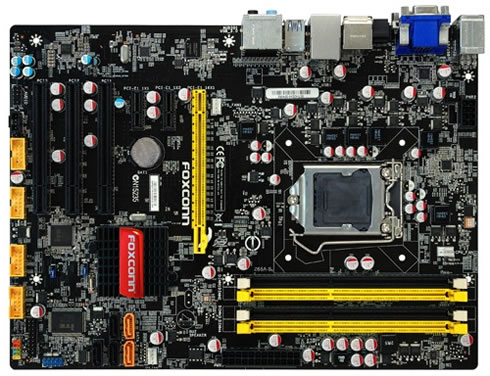
Lucid Virtu GPU Virtualization--- dynamic switching between built-in processor graphics and high-end 3D performance discrete graphics cards
Dynamically switch between onboard and discrete graphics with Lucid Virtu GPU Virtualization. Virtu analyzes your system usage and automatically switches to your discrete graphics card when playing 3D games and then back to onboard graphics for less demanding 2D applications. Simply put, discrete graphics power when you need it and power savings when you don’t.
Intel Smart Response Technology--- enabling SSD like performance with HDD capacity
The solid-state drive (SSD) cache helps to speed up your system by copying your most commonly used applications to an SSD cache for quicker access and load times. The SSD cache tech combines the benefits of SSD speed and traditional hard drive storage capacity while also reducing energy consumption.
CPU TURBO boost and K series CPU --- Unlock the multiplier
The latest "K" series of CPUs are specifically designed for the enthusiasts who wish to get the most from their systems and not be bound by a motherboard that can't reach a high BCLK. The K Series CPUs feature an unlocked multiplier allowing users to overclock safely regardless of motherboard limitations. Intel Turbo Boost Technology will automatically allow processor cores to run faster than the base operating frequency if it's operating below power, current, and temperature specification limits.
100% Japanese solid capacitors -Ultra reliability
With an average lifespan of 50,000 hours, these solid capacitors provide the stability, reliability and longevity essential to meet the power needs of high-end processors and other components running today's most demanding applications and games.
- Full Specifications
| Processor |
Intel Sandybridge processors, Socket LGA1155; |
| Chipset |
Intel Z68 |
| Memory |
·Supports 4x 240-pin DIMM of DDR3 SDRAM
-Black/yellow
·Supports 32GB memory size.
·Supports DDR3 2133(oc) / 1866(oc) / 1600(oc) / 1333 / 1066 memory architecture |
| VGA on Die |
|
| Expansion Slots |
·1 x PCI Express 2.0 x16 slots. (1x16)---Yellow
·2 x PCI Express x1 slot.--Black
·3 x PCI slot-Black |
| IDE |
N/A |
| Serial ATA(SATA)/RAID |
RAID 0, 1, 0, 1.5; Intel® Matrix storage technology
·SATAII controller integrated
- Up to 300MB/sec transfer speed.
- Support 3 internal SATAII devices. --> Black
·SATA3 controller integrated
- Up to 600MB/sec transfer speed.
- Support 2 internal SATA3 devices. --> Yellow
·1x E-SATAII ports |
| Audio |
·Audio chip
- Support 8 channel audio (colay 6 channel)
- Compliant with HDA interface.
|
| LAN |
Gigabit Lan |
| IEEE1394 |
N/A |
| Back Panel I/O Ports |
1 x PS/2 keyboard port
1 x VGA port
1 x DVI port
1 x S/PDIF out Optical port
1 x eSATAII port |
| Internal I/O Connectors |
1 x ATX 24-Pin power connector
1 x 8-pin ATX 12V power connector
1 x 4-pin CPU FAN connectors
2 x 4-pin System FAN connector
1 x Front panel header
1 x Front Audio Header
1 x COM header
1 x TPM header
4 x USB 2.0 connectors support additional 8 ports
3 x Serial ATAII connectors
2 x Serial ATAIII connectors
1 x Intruder Alarm headers
1 x S/PDIF out header
1 x CLR_CMOS header
1 x CD-IN header
1 x Speaker header |
| BIOS Features |
32Mb flash EEPROM w/ LAN boot PnP, ACPI, WfM, DMI 2.0 |
| Standards/Manageability |
USB3.0, DMI 2.0 |
| Form Factor |
ATX form factor 12.0 inch x 8.8 inch |
2. A closer look
The Foxconn Z68A-S motherboard would be priced at the price range of $120~160 (including VAT), depending on your region.
The retail package has the typical Foxconn Design with some sticker at the bottom left indicating the product's features.
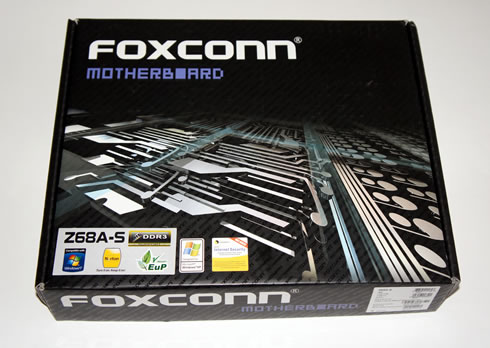
Once opened, other than the motherboard units, inside the packaging you'll find a a quick install guide, CD containing drivers and software, I / O panel bracket, and two SATA cables:

Foxconn Z68A-S comes with black PCB color with bright yellow accents on the PCI-Express x16 slots, DIMM slots, as well as several headers.
This motherboard use a standard ATX form factor Overall, there is one PCI-Express x16 slots, two PCI-Express x1 slots and three PCI slots.
The area around the CPU socket looks relieved:
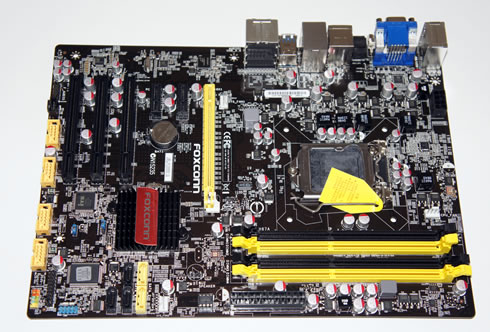
The positions of the basic elements / connectors on the PCB can be easily identified in the picture below:
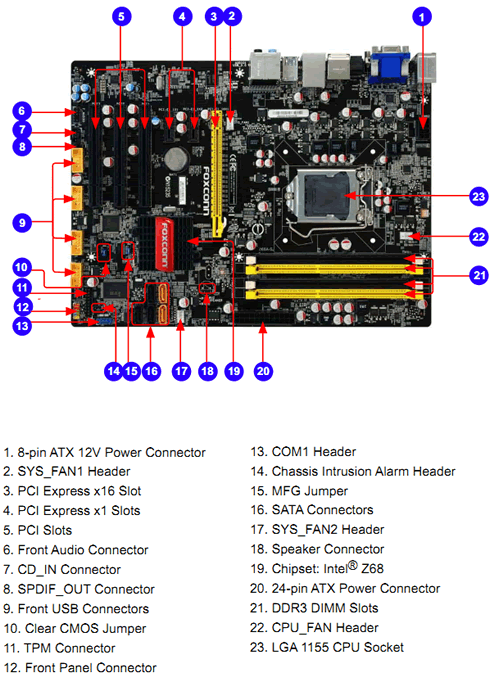
Although the motherboard is supposed to be designed for enthusiasts and overclockers, it has a simple 5-phase power VRM design, without any passive heat sinks found around the cpu area as we typically see in other motherboards:

You can install up to 32Gb of DDR3 2133MHz memory in the provided memory slots. However, XMP profiles are not supported:
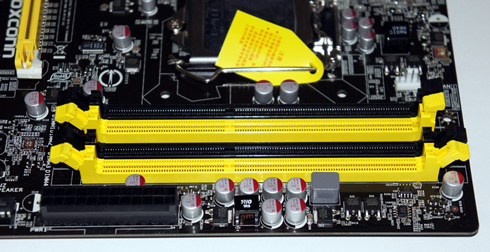
The backplate panel of I/Os includes:
- 1 x PS/2 keyboard port
- 1 x VGA port
- 1 x DVI port
- 1 x S/PDIF out Optical port
- 1 x eSATAII port

The motherboard supports:
- 1 x PCI Express 2.0 x16 slots. (1x16)---Yellow
- 2 x PCI Express x1 slot.--Black
- ·3 x PCI slot-Black
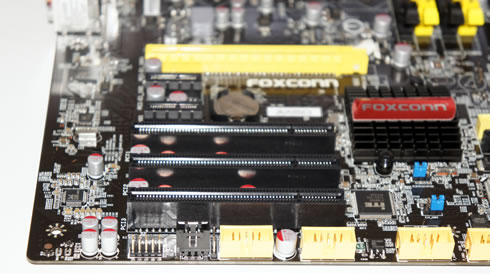
We were disappointed to see the lack of a second PCIe 2.0 slot for SLI/Crossfire setups. On the other hand, it includes 3 PCI slots:

On the left part of the mainboard there are 2x SATA 6.0 Gb/s ports (yellow) and 3x SATA 3Gb/s ports (black), handled by Intel's Z68 chipset.
Many additional internal I/O ports are also available:
- 1 x ATX 24-Pin power connector
- 1 x 8-pin ATX 12V power connector
- 1 x 4-pin CPU FAN connectors
- 2 x 4-pin System FAN connector
- 1 x Front panel header
- 1 x Front Audio Header
- 1 x COM header
- 1 x TPM header
- 4 x USB 2.0 connectors support additional 8 ports
- 3 x Serial ATAII connectors
- 2 x Serial ATAIII connectors
- 1 x Intruder Alarm headers
- 1 x S/PDIF out header
- 1 x CLR_CMOS header
- 1 x CD-IN header
- 1 x Speaker header
3. BIOS, bundled software
The Foxconn Z68A-S comes with the standard American Megatrends Bios design and not the UEFI BIOS met in some new motherboards. The specific BIOS layout is not the best we have seen since many settings are hidden into sub-menus and are not easily accessible, especially for inexperienced users. Foxconn could make some improvements here.
A quick overview of the BIOS is available in the video below:
- Foxconn One
With the FOX ONE utility, we expected to be able to modify system an performance settings, such as bus speeds, CPU voltages, fan speed, and other system performance options that are supported by the BIOS. However, both the "CPU" and "Frequency" tabs were disabled, allowing us only to monitor hardware temperature, voltage, frequency and fan speeds:



4. Benchmarks, Intel's Smart Response technology
We installed the Foxconn motherboard in the following PC:
- Motherboard: Foxconn Z68A-S with P05 BIOS
- CPU: Intel i5-2500K retail
- CPU Cooler: Arctic Cooling Freezer 13 Extreme
- Memory: Crucial Ballistix DDR3 PC3-17000 (BL2KIT25664FN2139)
- VGA: Gigabyte GT-430 (Nvidia Based)
- HDD: WD 5001ALLS (500GB, 7200rpm Black Scorpio series) + Seagate 7200.12 500GB
- OS: Windows 7 x64 SP1 with all the latest updates installed
- VGA driver: Nvidia 275.33 x64 drivers
The Foxconn Z68A-S came with BIOS Ver. P01 installed. We updated it to the latest available Ver. P05 . The BIOS update process was not simple and before attempting it, make sure you set the MFG jumper to pins 2-3 as the following picture indicates:

After powering up the motherboard, it automatically set the Intel i5-2500K processor's core to 1.6~3.4GHz (Speedstep Enabled) and the memory was locked at 1333MHz. In order to increase the memory divider you will also need to pump up memory voltage. A 100mV increase pushed the memory voltage to 1.656V and provided the required stability. In addition, you may also have to set timings manually, depending on your memory. In our case, by changing the tRCD to 10 we got a stable 2133MHz:



We ran PCMark 7, CineBench R11.5 the Sandra Memory benchmarks and below you see where the Foxconn Z68A-S stands compared with three other motherboards:
| |
PCMark 7 |
CineBench R11.5 |
Sandra Memory |
| Foxconn Rattler Intel i5-2500k @ 1.6~3.4GHz with DDR3-2133 |
3120 |
5.19pts |
27.00MB/sec |
| Asus Sabertooth Intel i5-2500k @ 3.7GHz with DDR3-2133 |
3272 |
5.90pts |
27.72MB/sec |
| Gigabyte Z68X-UD3P-B3 Intel i5-2500K @ 1.6~3.7GHz with DDR3-2133 |
2974 |
5.88pts |
27.34MB/sec |
| Foxconn Z68A-S Intel i5-2500k @ 1.6~3.4GHz with DDR3-2133 |
|
|
|
Let's move on to some tests taking advantage of the Intel's Smart Response Technology, supported by the Z68 chipset. The feature is an intelligent caching technology that puts an SSD between the hard drive and operating system. The scheme uses logic built into the chipset's storage controller and drivers to populate a solid-state drive with frequently accessed data and incoming writes.
Smart Response is capable of caching writes immediately, but data must be read at least once to make it onto the SSD.
To enable Smart Response, the Z68's SATA controller must first be put into RAID mode. From there, one selects the hard drive to accelerate and how much of the SSD's capacity the cache will occupy. The cache needs at least 18GB and will only consume up to 64GB. You can use any SSD you'd like.
Smart Response process runs in maximized or enhanced mode. Enhanced mode is the default mode and it used the write-through cache method to write data to the cache memory and the disk simultaneously. In the even that the accelerated disk or volume becomes inaccessible, fails, or is disconnected, there is no risk of data loss because data on the disk is always synchronized with the data in the cache memory. The user can move his hard drive to a new system without bringing the SSD in tow.
Write caching is available in maximized mode. To guard against data loss, Smart Response works constantly to push cached writes to the hard drive and freshen the data it has stored for reads. The hard drive won't be perfectly in sync with the SSD in maximized mode, so migrating that kind of setup to a new system requires moving the SSD and hard drive together or disabling the cache beforehand.
In order to accelerate your disk subsystem by making use of Intel's Smart Response technology it is not enough just to connect an SSD to your computer. You'll get an error message telling you that the system doesn't meet the minimum requirements or even a BSOD, unless you have previously set your SATA ports to RAID Mode before installing your operating system. The next step would be to install the Intel Rapid Storage driver and then configure the Intel Smart Response.
Foxconn is not offering any software utility that could save you from following all these steps before using the Intel's Smart Response technology for the first time. So unless you had set your SATA ports to RAID Mode before installing Windows, you will have to make a fresh installation of your OC as we previously described.
We installed a Crucial m400 256GB SSD to our system. 64GB of SSD space will be allocated by the system and the rest capacity will be available for use:

Once you are ready to configure the Intel Rapid Storage utility, push the "Accelerate" button. We selected the "Enhanced Mode" :


The PCMark 7 test benchmark suite showed that the Intel Smart Response technology gave a boost to our system's performance. However, as you can see in the table below, a Gigabyte motherboard performed much better than the Foxconn Z68A-S:
| PCMark 7 Test |
Foxconn Z68A-S Intel i5-2500K @ 1.6~3.4GHz with DDR3-2133 & SSD Acceleration |
Gigabyte Z68X-UD3P-B3 Intel i5-2500K @ 1.6~3.7GHz with DDR3-2133 & SSD Acceleration |
| PCMark Score |
4112 |
4418 |
| Lightweight Score |
4185 |
4548 |
| Productivity Score |
3982 |
4813 |
| Creativity Score |
4409 |
4561 |
| Entertainment Score |
3535 |
3606 |
| Computation Score |
4243 |
4450 |
| System Storage Score |
4172 |
4441 |
5. Overclocking, Bulit-in graphics benchmarks, Lucid Virtu GPU Virtualization
- Overcloking
The Foxconn designed the Z68A-S for "advanced gamers and overclocking fans". The reality is that we had hard times getting the system stable under overclocking.
Although we set the proper Vcore voltages through the BIOS, the system did not apply them and under the VCore remained unchanged under Windows.
In addition and after many re-tries, when the system was reaching the desired core speed (for example 42x X 100), somehow the multiplier was automatically decreased again.
The "auto" settings won't get you above 35X for an Intel i5-2500K processor. In some cases we managed to set the multiplier high and the CPU reached the 4.5GHz. However, this was not stable at all since any manually set Vcore voltages through the BIOS were not properly applied.
We hope that Foxconn will improve this behavior and offer some decent overclocking margins with its Z68 motherboard.
- Intel HD 3000 Graphics
The new Sandy-Bridge processors from Intel feature an improved integrated graphics chip, the Intel HD Graphics 3000. Do not expect a performance comparable to a discrete graphics solution - these graphics are just enough for office and some basic gaming.
Alike the actual cores of the CPU, the integrated HD Graphics 3000 can dynamically adjust its clock rate upon increased load (Turbo Boost). The Intel HD Graphics 3000 has 12 Execution Units (comparable to pipelines). Despite the same number than in the GMA HD, they have been improved and are now clearly faster than in the predecessor.
The default clock speed for both HD 3000 on the desktop is 850MHz; however, the GPU can turbo up to 1100MHz.
Furthermore, the HD Graphics 3000 got a unit dedicated to decoding and encoding of HD videos. In addition it supports DirectX 10.1, Shader Model 5.0 and HDMI 1.4 (support of 3D displays).
Windows update will automatically download the latest driver for the Intel HD 3000 graphics .The e GPU-Z utility provides some information about the HD HD Graphics 3000:

The Intel HD Graphics driver offers several options and settings to play with:


Below you see the performance of Intel's HD 3000 graphics during casual gaming, using low quality settings in most of the games:
Game Title |
Quality Settings |
Resolution |
Performance (average FPS) |
| Dawn of War II |
Low |
1024x 768 |
34 |
| BioShock 2 |
Low |
1024x 768 |
33.5 |
| Call of Duty: Modern Warfare 2 |
Low |
1024x 768 |
41 |
| World of Warcraft |
Fair |
1024x768 |
45 |
| HAWX |
Low |
1024x768 |
72 |
| Call of Duty: Black Ops |
Low |
1024x 768 |
28 |
| DiRT 2 |
Low |
1024x 768 |
28 |
| Unigine Benchmarking software |
Shaders High, x16xAA |
1280x1024 |
8.4 |
It is obvious that the Intel HD 3000 is offering casual mainstream gaming capabilities at performance levels of an entry-level discrete graphics card.
- Lucid Virtu GPU Virtualization
The Foxconn designed the Z68A-S motherboard has been designed to dynamically switch between built-in processor graphics and an installed discrete graphics card. This operation is powered by the Lucid Virtu GPU Virtualization technology. Virtu analyzes your system usage and automatically switches to your discrete graphics card when playing 3D or demanding games and then back to onboard graphics for less demanding applications. In order to take advantage of the feature you should use any of the following graphics cards: Nvidia 2xxx, 4xxx, 5xxx and ATI 4xxx, 5xxx and 6xxx series.
Unfortunately, the Lucid Virtu graphics driver kept refusing to install when we tried to use the feature with an Nvidia GT 430 and a GTX 560Ti graphics cards.
6. Final words
The Foxconn Z68A-S is an affordable motherboard for the LGA 1155 socket processors, designed to offer all these new features of the Intel Z68 chipset. Packed with a Sandy Bridge processor such as the Intel i5-2500K, it potentially offers a great platform for overclocking, performance through Intel's SSD caching features as well as smart graphics switching between the built-in processor HD graphics and an installed discrete graphics through the Lucid Virtu GPU Virtualization technology. However, all these are only part of the theory, as Foxconn's motherboard needs further optimization in order to attract overclockers and hardware enthusiasts.
The motherboard's performance was adequate in PCMark 7, CineBench R11.5 and the Sandra Memory benchmarks. In order to get your memory run at 2133MHz you'll have to manually make some adjustments, but nothing you won't be able to handle. No worries here, as the motherboard will operate with stability and may be a little bit faster than other Z68 solution such as the Gigabyte Z68X-UD3P-B3 we recently reviewed.
On the other hand, the motherboard could not operate in a stable manner under overclocking. The BIOS refused to apply any settings we manually tried to apply and it kept returning to stock speeds. This strange behavior could be attributed to either our CPU/memory or to a poor BIOS optimization by Foxconn's engineers. The latter seems to be closer to the truth as we have been using these same components with many other motherboards with great results.
Another issue we encountered was when we tried to use the Intel Smart Response technology. Once we installed the latest stable Intel RST Storage driver, our system's main HDD (WD 5001ALLS 7200 Black Scorpio Edition) just disappeared, indicating either a motherboard or a HDD incompatibility. Hopefully, we finally managed to run some system benchmarks and the Intel Smart Response technology proved to offer the expected boost to our system's performance.
The Foxconn Z68A-S motherboard is offering video outputs, allowing us to take advantage of the Intel HD 3000 graphics core of our Intel i5-2500K processor. Our benchmarks showed that the Intel HD 3000 is offering casual mainstream gaming capabilities at performance levels of an entry-level discrete graphics card. This means that you'll be probably able to play your favorite game as long as you keep the quality settings and the resolution low. In addition, you'll be able to playback your favorite MKV video files.
Speaking of graphics, we could not install the Lucid Virtu graphics driver to the Foxconn system in order to make some tests. Although all the Nvidia 2xxx, 4xxx, 5xxx and ATI 4xxx, 5xxx and 6xxx series should be supported, we had problems using the feature with our Nvidia GT 430 and GTX 560Ti graphics cards.

The Foxconn Z68A-S is an affordable, entry-level motherboard aimed mostly for users seeking for a stable operation and good performance levels but only at default speeds. For sure, Foxconn could make this motherboard much more competitive and attractive to experienced users by making BIOS optimizations.
Positive
- Very good build quality & clean layout
- Stable operation and good performance under default speeds
- Supports up to 2133MHz DDR3 memory
- SATA2 & SATA3 ports
- Graphics outputs (for CPU graphics)
- Intel
Smart Response adds additional performance boost
- Affordably priced
Negative
- BIOS seems kind of messy
- Foxconn One software doesn't fully support this motherboard
- Vcore adjustments could not be applied
- Motherboard doesn't support X.M.P. memory profiles.